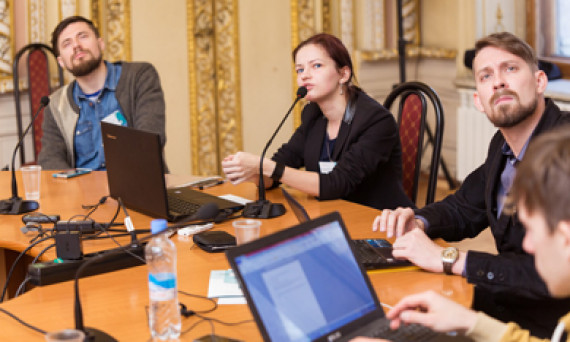This section of the VDNH VIII conference was devoted to the topic of urban transportation. The panel’s inspirer and organizer Andrei Kuznetsov (PAST-Center, Tomsk State University/Volgograd State University) pointed out that a critical mass of research on urban transportation has appeared in Russia — we are possibly on the verge of a whole wave of academic texts on the “turn toward mobility.” Public transportation exists simultaneously as both a place and object of research, and is viewed with both social and technological criteria. The section’s reports all balanced on the intersection of these two perspectives, and considered various types of transportation such as bicycles, trams, and marshrutkas.
Cycling activist and researcher Irina Troshina (EUSP) spoke about the space allocated to bicyclists in urban St. Petersburg. A lack of support from the administration as well as poorly developed infrastructure has impeded many citizens from using bicycles as everyday transport. There has been some progress, however, and new traffic ordinances have finally “noticed” cyclists. On the one hand, bicycles have been given a more detailed legislative definition, but on the other they have been presented with new technical requirements. In his commentary, Andrei Kuznetsov noted that the situation with cycling activism has given us the opportunity to revise our view of (Russian) authorities: while some struggle with classification, others actively advocate for inclusion.
Anton Polsky (EUSP) remarked that many people ride bicycles in order to remain outside the system—in particular, traffic policeman cannot stop them and ask for a bribe. Polsky also spoke about the experience of cycling activists in Moscow. A leitmotif of his report was the transition from bicycling fans into the position of experts through their mapping of bike routes, gathering feedback from the local community and developing media platforms to popularize bicycling. The matching of bicyclist’s interests with options offered by local authorities does not always unfold without conflict, but it does often provide an impetus for reflecting on the relationship of bicycles to other mechanical means of transport (skateboards, for example) as well as their social significance to those for whom, for whatever reason, they are difficult to use (such as young parents with strollers).
Denis Sivkov (RANEPA) mentioned several films about the experience of being a passenger and elaborated on John Ford’s “Stagecoach.” In “Stagecoach,” public transportation is not merely decoration — it sets the scene for the film’s action. Ford’s film shows how patterns of social interaction are tied to the physical parameters of interior spaces. We can see parallels between marshrutka taxi and stagecoach: overcrowdeness, particular set of passenger micro-practices, and latent rules of etiquette. This gives rise to short-term and fluid mobile modes of justice. The director’s point of view — the interior of a cabin provides an interesting case for contemporary researchers who are opening the “black box” of public transportation to ethnographic observation.
Andrei Vozyanov (EUSP) spoke about urban electric transport, which has been traditionally excluded from the conversation about DIY practices of urban mobility and is considered to be derived from and dependent on politics and high-level politicians. Field research was conducted on the cases of exception to this general rule in small towns in Ukraine (a Romanian case study has yet to be explored) where residents are actively involved in maintaining the infrastructure of trams.
Ilyas Tugushev (EUSP) presented material from a research project on Volgograd marshrutkas. Central to his report was the issue of overlapping of public and private in marshrutka taxis. In 2013, the Volgograd administration proposed to replace microbuses with high-capacity transportation. In the conflict that followed various urban actors gave voice to the role of marshrutkas in the city, the criteria of passenger service comfort and quality, and the impact on ecology.
At the end of the conference section, Andrei Kuznetsov (PAST-Center, Tomsk State University) presented his text titled “Aramis in Volgograd, or, the Malebranche World of Marshrutka Taxis.” At first glance, there is not much in common between the futuristic high-tech project in 1980s Paris and the realities of transportation in Volgograd. But both technologies — Aramis and the marshrutka — attempt to change the usual distribution between humans and artifacts in the implementation of mobility. The section ended on this intriguing note: today, transportation is a very promising subject that is rapidly becoming popular both for theoretical constructs as well as applied research work.
Andrei Vozyanov










